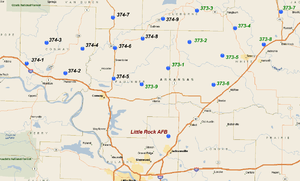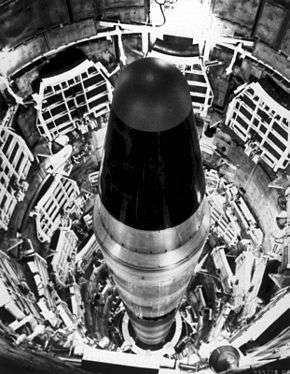1980 Damascus Titan missile explosion


The Damascus Titan missile explosion was an incident in the United States in 1980 in rural Arkansas. Liquid fuel in a U.S. Air Force LGM-25C Titan II intercontinental ballistic missile exploded at a missile launch facility on September 19, 1980. It occurred at Launch Complex 374-7 in Van Buren County farmland just north of Damascus, approximately fifty miles (80 km) north of Little Rock.[1][2]
The Strategic Air Command facility of Little Rock Air Force Base was one of eighteen silos in the command of the 308th Strategic Missile Wing (308th SMW), specifically one of the nine silos within its 374th Strategic Missile Squadron (374th SMS), at the time of the explosion.
Incident
Around 6:30 p.m. CDT on Thursday, September 18, 1980, two airmen from a propellant transfer system (PTS) team were checking the pressure on the oxidizer tank on a USAF Titan-II missile at Little Rock AFB's Launch Complex 374-7. Due to time constraints when going into the silo, a previously acceptable ratchet and socket (3 ft (0.9 m), 25 lb (11 kg)) was taken instead of the newly mandated torque wrench. The 8 lb (3.6 kg) socket was accidentally dropped approximately 80 feet (24 m) before hitting a thrust mount and piercing the skin on the missile's first-stage fuel tank, causing it to leak a cloud of its aerozine 50 fuel.

Aerozine 50 is hypergolic with the Titan II's oxidizer, nitrogen tetroxide; i.e., they spontaneously ignite on contact with each other. The nitrogen tetroxide is kept in a second tank in the rocket's first-stage, directly above the fuel tank and below the second-stage and its 9-megaton W53 nuclear warhead.
Eventually, the missile combat crew and the PTS team evacuated the launch control center, while military and civilian response teams arrived to tackle the hazardous situation. There was concern for a possible collapse of the now empty first-stage fuel tank, which could cause the rest of the missile to fall and rupture, allowing the oxidizer to contact the fuel already in the silo.

Early in the morning (Friday, September 19), a two-man PTS investigation team entered the silo. Because their vapor detectors indicated an explosive atmosphere, the two were ordered to evacuate. The team was then ordered to reenter the silo to turn on an exhaust fan. Senior Airman David Livingston reentered the silo to carry out the order and shortly thereafter, at about 3:00 a.m., the hypergolic fuel exploded. The initial explosion catapulted the 740-ton silo door away from the silo and ejected the second stage and warhead. Once clear of the silo, the second stage exploded. The W53 warhead landed about 100 feet (30 m) from the launch complex's entry gate; its safety features operated correctly and prevented any loss of radioactive material.
Senior Airman David Livingston (posthumously promoted to Sergeant), was seriously injured and later died at the hospital, while 21 others in the immediate vicinity of the blast were seriously injured.[3][4] The entire launch complex was destroyed.[3]
At daybreak, the Air Force retrieved the warhead and took it to Little Rock AFB. During the recovery, the 308th Missile Wing's commander, Col. John Moser, received strong support from other military units as well as federal, state, and local officials.[5][6]
The former launch complex was decommissioned and disassembled, and now stands on private land.[7] The site was listed on the National Register of Historic Places in 2000.
Popular culture
A 1988 television movie, Disaster at Silo 7, is based on this event.[8]
In September 2013, Eric Schlosser published Command and Control: Nuclear Weapons, the Damascus Accident, and the Illusion of Safety.[9] It focused on the explosion, as well as other Broken Arrow incidents during the Cold War.[10][11]
A documentary film titled Command and Control from director Robert Kenner, based on the book by Eric Schlosser, was released January 10, 2017. The film was broadcast by PBS as part of its American Experience series. [12]
See also
- List of military nuclear accidents
- National Register of Historic Places listings in Van Buren County, Arkansas
References
- ↑ "Missile silo blast probed". Chicago Tribune. wire services. September 20, 1980. p. 1, sec. 1.
- ↑ "Missile silo blast kills 1, hurts 21; no radiation leak". St. Petersburg Times. (Florida). AP, UPI. September 20, 1980. p. 1-A.
- 1 2 "Titan Missile Explosion". The Encyclopedia of Arkansas.
- ↑ SGT David Lee Livingston at Find a Grave
- ↑ "'What warhead?' Air Force aides ask". Chicago Tribune. wire services. September 21, 1980. p. 3, sec. 1.
- ↑ "Air Force truck removes damaged warhead". Eugene Register-Guard. (Oregon). UPI. September 22, 1980. p. 1A.
- ↑ Schlosser, Eric (2013). Command and Control: Nuclear Weapons, the Damascus Accident, and the Illusion of Safety. Penguin Press. p. 484. ISBN 978-1-59420-227-8.
- ↑ "Disaster at Silo 7". 27 November 1988. Retrieved 18 May 2017 – via IMDb.
- ↑ Greta Johnsen. "Five Books To Read This Fall".
- ↑ Walter Russell Mead (2013-09-12). "Atomic Gaffes: Command and Control by Eric Schlosser". The New York Times. Retrieved 2013-09-18.
- ↑ McKinley, James (2012-10-05). "Fast Food Nation Author Will Return With Book on Nuclear Weapons". The New York Times. Retrieved 2012-10-06.
- ↑ "Command and Control - American Experience - WGBH - PBS". www.pbs.org. Retrieved 18 May 2017.
Coordinates: 35°24′51″N 92°23′50″W / 35.4141°N 92.3972°W